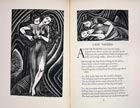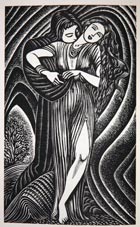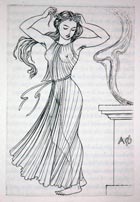Cabinet 14
  |
After working on Endymion, JBW returned to another favourite, Swinburne, that 'braggart in matters of vice' according to Oscar Wilde. In Laus Veneris (In Praise of Venus), Swinburne reworked the figures of Venus and Adonis in his own controversial style. JBW's illustrations are drawn in an extremely delicate sensuous line, an intentional figure type for him. He said as much to Sandford: 'If you had thought a little you would have realised that every artist creates his own type and it varies exceedingly little. Just think of Rubens, Poussin, Ingres and Renoir as examples...'. This edition of 650 copies contains eleven engravings. Algernon Charles Swinburne, Laus Veneris. London: Golden Cockerel Press, 1948. Special PR 5508 L3 1948. |
  |
Hero was a priestess of Aphrodite who dwelt in a tower in Sestos, at the edge of the Hellespont. Leander was a young man from Abydos on the other side of the strait, who fell in love with her. He swam the Hellespont every night to be with her. Hero would light a lamp every night at the top of her tower to guide his way. It is significant that six books published by Golden Cockerel Press were based on Greek themes which found a sympathetic chord with JBW: Hymn to Prosperine (1944), Hero and Leander (1949), Pasiphaë (1950), Salmacis and Hermaphroditus (1951), The Grecian Enchanted (1952), and L'Après-midi d'un Faune (1956). Here JBW weaves his magic into Hero and Leander, the epic poem by Musaeus. The translator, F.L. Lucas, thought the book “all quite delightful. It will be an heirloom indeed!’ Musaeus, Hero & Leander. Translated by F.L. Lucas. [London, C. Sandford, 1949]. Special PA 4250.M5 H4 1949. |
 |
'John Buckland Wright was the creative artist; his craft spell-binding. The engraving flowing from his burin was in the same degree as that of the engravers he admired so much, Antonio Polliauolo, Andrea Mantegna and Martin Schongauer. (Garrett, from Engravings, 1990). At Christopher Sandford's instigation, JBW illustrated Swinburne's poetic and controversial version of Pasiphaë, the ancient myth about Pasiphaë, the wife of King Minos, who, because of Poseidon's machinations, was made to fall in love with a snow-white bull. The result of this unnatural union was the Minotaur, a monster with the body of a man and the head of a bull. This is one of six copper engravings in the Golden Cockerel edition of 400 copies. Algernon Charles Swinburne, Pasiphaë. [London, Golden Cockerel Press, 1950]. Special PR 5506 P37 1950. |
| «Previous | Next» |
